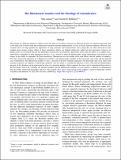The Mnemosyne number and the rheology of remembrance
Author(s)
Jamali, Safa; McKinley, Gareth H.
Download1027_1_online.pdf (1.992Mb)
Publisher Policy
Publisher Policy
Article is made available in accordance with the publisher's policy and may be subject to US copyright law. Please refer to the publisher's site for terms of use.
Terms of use
Metadata
Show full item recordAbstract
The concept of a Deborah number is widely used in the study of viscoelastic materials to represent the ratio of a material relaxation time to the time scale of observation and to demarcate transitions between predominantly viscous or elastic material responses. However, this construct does not help quantify the importance of long transients and nonmonotonic stress jumps that are often observed in more complex time-varying systems. Many of these nonintuitive effects are lumped collectively under the term thixotropy; however, no proper nouns are associated with the key phenomena observed in such materials. Thixotropy arises from the ability of a complex structured fluid to remember its prior deformation history, so it is natural to name the dimensionless group representing such behavior with respect to the ability to remember. In Greek mythology, Mnemosyne was the mother of the nine Muses and the goddess of memory. We, thus, propose the definition of a Mnemosyne number as the dimensionless product of the thixotropic time scale and the imposed rate of deformation. The Mnemosyne number is, thus, a measure of the flow strength compared to the thixotropic time scale. Since long transient responses are endemic to thixotropic materials, one also needs to consider the duration of flow. The relevant dimensionless measure of this duration can be represented in terms of a mutation number, which compares the time scale of experiment/observation to the thixotropic time scale. Collating the mutation number and the Mnemosyne number, we can construct a general two-dimensional map that helps understand thixotropic behavior. We quantify these ideas using several of the simplest canonical thixotropic models available in the literature.
Date issued
2022-08-29Department
Massachusetts Institute of Technology. Department of Mechanical Engineering; Hatsopoulos Microfluids Laboratory (Massachusetts Institute of Technology)Journal
Journal of Rheology
Publisher
Society of Rheology
Citation
Safa Jamali, Gareth H. McKinley; The Mnemosyne number and the rheology of remembrance. J. Rheol. 1 September 2022; 66 (5): 1027–1039.
Version: Final published version
ISSN
0148-6055
1520-8516
Keywords
Mechanical Engineering, Mechanics of Materials, Condensed Matter Physics, General Materials Science